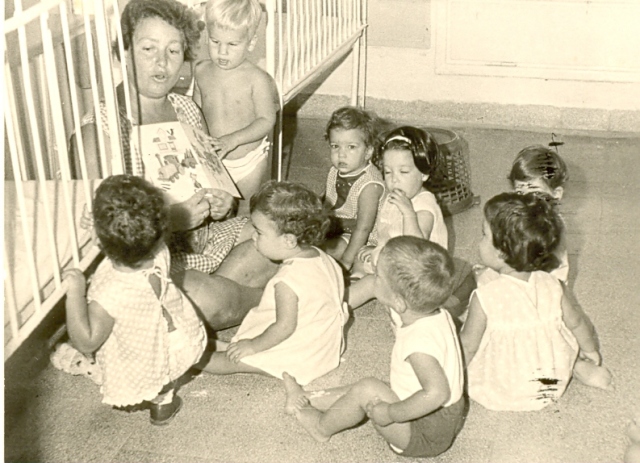This short piece investigating what life could be like for children in a communist society first appeared in Organise! #81.
“You must understand that once we have property in common, and establish on a solid moral and material base the principle of social solidarity, the maintenance of the children will be the concern of the community, and their education will be the care and responsibility of everyone.
Probably all men and all women will love all the children; and if, as I believe is certain, parents have a special affection for their own children, they can only be delighted to know that the future of their children is secure, having for their maintenance and their education the cooperation of the whole society.”
– Errico Malatesta, At the Cafe.
This piece will be a very brief glance through squinted eyes at what early life could look like in an anarchist utopia. While we may seem a long way from communal life, it is important to have some conception of the ideals we are trying to prefigure in our lives hear and now. Speculation on the early stages of someone’s life in a society led by anarchist communist principals, far from being a waste of time, can help make our groups more accessible to those with a duty of care today. Many instances of communal childcare and alternatives to early life exist to point the way towards a better world.

The Kibbutz
A kibbutz (plural kibbutzim, originally meaning a cluster or gathering) is the name for what was traditionally a Jewish communal community. While it is imposable to sum up the history of hundreds of settlements formed over a hundred years in a neat package, the first kibbutzim were established early in the twentieth century, primarily as farming communes that aimed towards the agricultural settlement of the land of Israel. While in recent history most have changed their ideology towards one of capitalist individuality and nationalism, many of the initial pioneers did not want to recreate the old order of settlements where Jews acted as bosses and Arabs were brought in as workers but instead sought to forge new paths in the Zionist movement based on a utopian socialist programme.
Part of this drive led to the tasks of childrearing, both social and economic, being seen as a responsibility of the whole kibbutz. As such the all children were given the same opportunities and options without the economic situation of the parents giving rise to bias towards one child or another. Children would live collectively in a separate building to the parents, share the same meals and enjoy the lifestyle.
After being weaned a child would be assigned to a nanny who’s job was not only to watch over a small group of children, but to also teach them the social skills of co-operation, mutual support and compassion. The nanny would also support visiting family members in learning essential parenting skills “on the job”. The nanny would be joined in helping the children by a formal teacher when the children turned 7, and this group would stay together up until teenhood. After this point the youngsters would move into larger dormitories, visiting home several times per week, while the nanny and teacher would separate from the group and a new wave of teachers would take responsibility for the group’s development.
Children would become responsible for maintaining elements of their environment such as their living space, vegetable gardens and even assistants to young nanny groups. A multidisciplinary approach to education was offered so that everyone would pick up some practical skills while at the same time nurturing those with a particular aptitude to excel in their chosen field.
While this method of child-rearing has ended in the kibbutzim, echoes of this method can be seen in modern speculative fiction such as Embassaytown by China Mieville.

Alternate Education
There are many alternatives to the current mainstream option for education. While it is outwith the scope of this piece to give a comprehensive list of all possible options, or to even go into any great depth on any one, it is worth mentioning a few of the different modes developed that have elements more suited to anarchist communism.
Unschooling / Autonomous Education
This method of home-schooling assumes that children have a natural disposition to wanting to learn. It also works on the basis that as each child will have their own preference on how to search for and digest information and so it is the child themselves who should pick the methods by which they undertake this task. Youngsters are encouraged to peruse subjects they have an interest in, with parents sharing in the task of looking into areas of enquiry with them and helping the student find the information they seek. Parents provide resources, make suggestions, provide text and create learning plans, though as the child gets older the parents pass more and more of the responsibility of these tasks onto their child.
Sudbury Schools
These are schools where the staff and the pupils are all part of the same directly democratic learning establishment and have an equal say in how it is organised. It is assumed that children already posses the main behaviours needed to advance in society and so by engaging in directly democratic methods of organisation the child will find the best way for them to be part of a directly democratic society. While there are no formal rules to begin with and rooms of these schools are not designated for particular tasks, weekly collective meetings allow for new rules to be introduced, learning programmes started or altered, areas of the school designated to certain activities, complaints heard out and staff hired or fired.
Montessori Education
This mode of education looks to guide children along a certain developmental paths. This is done by having a “prepared environment” that has features that are of interest to most people in the specific age band as well as features specifically introduced to suit those learning in the space with an eye to bringing forward the qualities that the community wish to foster in their youth. Lessons are presented by teaching staff however it is the students who pick which topics of enquiry to follow up upon, and student-led trips outside the classroom to find new information (known as “going out”) is a key element of this style of education.

Becoming a Grown-up
A final question that has to be asked of communal society is at what point are you considered to have full responsibilities as a member of the commune? Even more fundamentally are the ideas of grading personal responsibility by age overly arbitrary or proscriptive? At what point does a duty of care impinge on another’s freedom of choice?
Concepts of free association would suggest that any individual should be free to apply to join or leave a community or workplace as they feel inclined to do so, or the community to associate or dissociate from individual as it sees fit. Extending this logic to the youngest members of our society they are in a position where they are subject in many ways to the communities choices until either party decide otherwise.
At this point someone may call for the ward of the community to be emancipated and free to be a full part of commune life, perhaps mainly considered after a certain period of learning. Conversely if a person felt that their freedoms were being hampered in one community they would always be free to leave and join another.
Living the Dream
All this utopian thinking leaves a lot for the anarchist groups to act on in the here and now. We can’t just wait for a member of the group to pop out a sprog or hope that parents will fit social revolution around the childcare. Instead we should make our groups seem inviting and supportive of those with children, starting our drives for social change with the social groups closest to us. The examples of support from the kibbutz can be taken not only to offer childcare in meetings, but to offer support to carers at other times when they need some space. We must understand that even out closest comrades now have a whole new focus in life when they take on the duty of care to a young life. They require us to undertake self-education and skill-sharing rather than shirking at the idea of children being near to us.
We must also look at the question of at which point the children have a say in decisions that will effect their lives and can take on responsibilities as part of our groups, because if we cannot show our wards the same respect we would show a stranger then what hope do we have of them taking forward ideas of social change in their lives? The children of today are revolutionaries of tomorrow. If we are serious about future generations growing up in an anarchist communist world then we have to prefigure that outcome today.
 Around 20 local anarchists, friends & badgers visited the HQ of the Bristol CID & Special Investigations at Sir Kenneth Steele House on Feeder Road in Bristol last Saturday 15th November. Officers operating from there have recently been visiting people’s homes and workplaces, harassing and putting pressure on local activists, musicians and their friends to become informants for the police. As a response, it was decided to turn the tables and start asking some questions of our own.
Around 20 local anarchists, friends & badgers visited the HQ of the Bristol CID & Special Investigations at Sir Kenneth Steele House on Feeder Road in Bristol last Saturday 15th November. Officers operating from there have recently been visiting people’s homes and workplaces, harassing and putting pressure on local activists, musicians and their friends to become informants for the police. As a response, it was decided to turn the tables and start asking some questions of our own.












You must be logged in to post a comment.